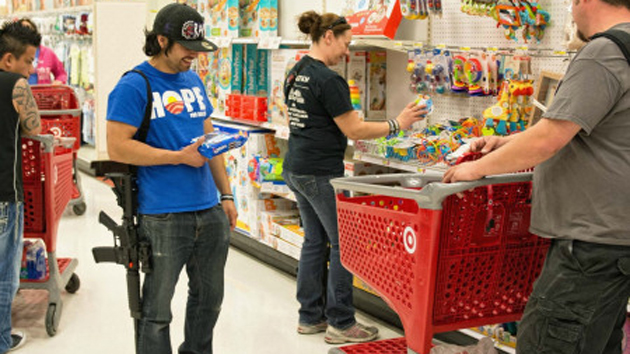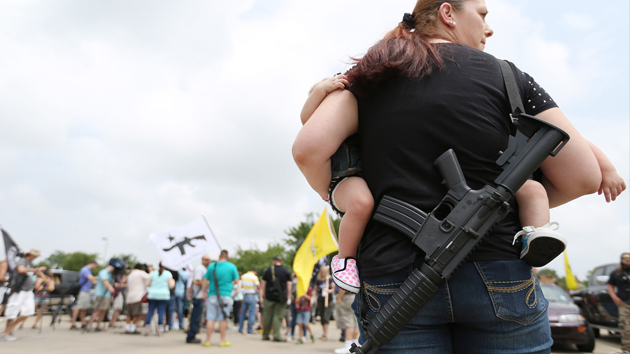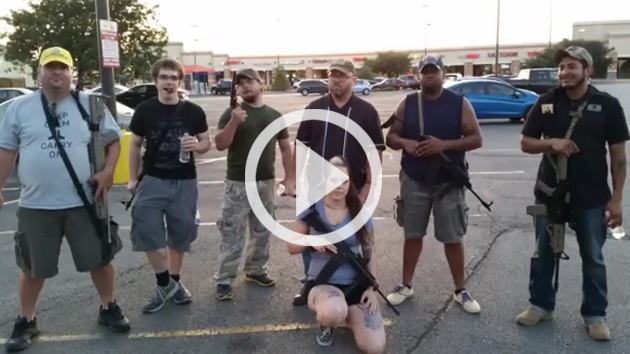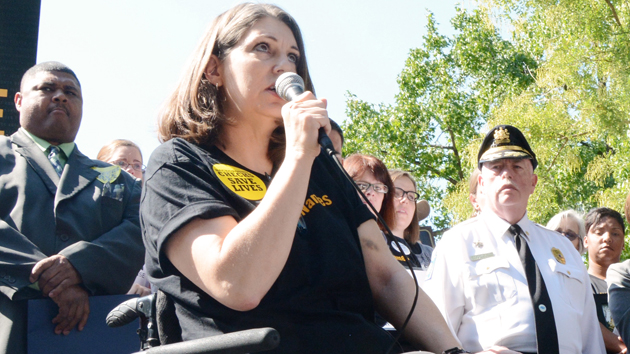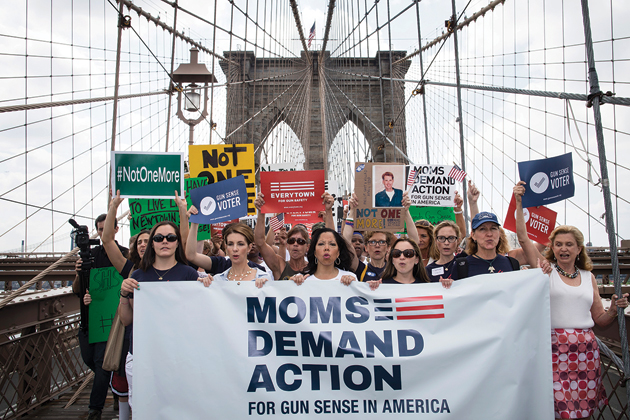
Kelly Bernado woke to the headlines after working her late shift as an ER nurse in Seattle, and she cried through the day and into the next, the shooting at her own son’s high school a year before haunting her all over again. In Houston the morning after it happened, Kellye Burke was on her way to pick up a Christmas tree, her six-year-old son nestled in his car seat, when she saw the large LED road sign publicizing a gun show and felt the urge to scream. In Brooklyn, Kim Russell felt a surge of adrenaline when she heard the news; after choking back the nausea, she began agonizing about what her first-grader would hear at school. She’d never told her daughter about the time when a robber shot her friend to death and wounded her, then pressed the cold muzzle against her forehead as she begged for her life.
At home in an Indianapolis suburb the morning following the massacre at Sandy Hook Elementary, Shannon Watts, a 41-year-old former public relations executive and mother of five, created a Facebook page calling for a march on the nation’s capital: “Change will require action by angry Americans outside of Washington, D.C. Join us—we will need strength in numbers against a resourceful, powerful and intransigent gun lobby.” The seed for Moms Demand Action for Gun Sense in America—today a national organization backed by nearly 200,000 members and millions of dollars—had been planted. “I started this page because, as a mom, I can no longer sit on the sidelines. I am too sad and too angry,” Watts wrote. “Don’t let anyone tell you we can’t talk about this tragedy now—they said the same after Virginia Tech, Gabby Giffords, and Aurora. The time is now.”
Three days later, five women convened in Brooklyn for a Skype call with Watts and formed the group’s first chapter. They felt that what happened in Newtown was like another 9/11. None of the women had experience as political activists, but they did remember Mothers Against Drunk Driving, the pioneering grassroots movement of the 1980s that rewrote laws and battled cultural resignation about alcohol-related traffic deaths. They also realized they had an asset that MADD organizers could only have dreamed of: social media. As word of a new effort to confront gun violence sprang up in Facebook feeds, offers flooded in to help launch more chapters, from Virginia and Texas to Kentucky and Colorado.
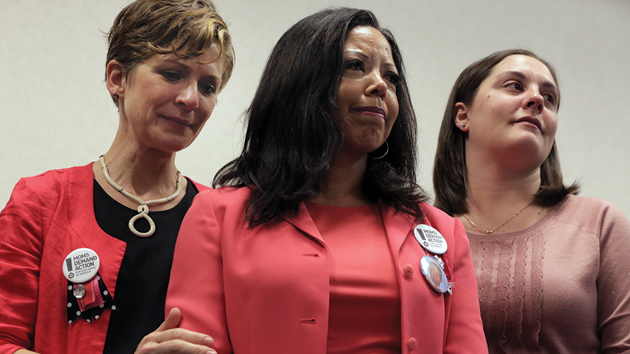
Today, Moms Demand Action has teams on the ground in all 50 states, elbowing their way into policy hearings and working to motivate “gun sense voters” fed up with the carnage. In less than two years, the organization has compelled more than a half-dozen national restaurant chains, internet companies, and retailers to take a stand against lax gun laws, and has joined forces with one of the nation’s most deep-pocketed political operators to hold elected leaders to account. Many groups have taken on the nation’s 30,000 annual firearm deaths—and this latest effort bears resemblance to the Million Mom March in the wake of the 1999 Columbine shooting, whose organizers also sought to be “a MADD for guns.” But no group has risen so far, so fast, influencing laws, rattling major corporations, and provoking vicious responses from hardcore gun rights activists. With its ambition to turn out a million voters for the November midterms, Moms Demand Action may be emerging as a potent threat to the National Rifle Association’s three-decade-long stranglehold on gun politics.
If stricter national gun laws seemed imminent in the aftermath of Sandy Hook, just four months later the popular narrative was that any chance for change had been deep-sixed. A majority in the US Senate approved universal background checks for gun buyers, but the bill fell a few votes short of the 60 needed to overcome a Republican filibuster. Once again, the NRA had won.
But Moms Demand Action took the fight to another arena—public opinion, with a special focus on brand-conscious corporate America. After Sandy Hook, Second Amendment activists had stepped up a tradition of openly carrying firearms into Starbucks stores (“open carry” is legal to varying degrees in all but a few states), so in May 2013, Moms launched a campaign urging members to “#SkipStarbucks” on Saturdays and post pictures of themselves having coffee elsewhere. Watts and Kate Beck, a Moms leader in Starbucks’ hometown of Seattle, published a scathing op-ed on CNN.com calling out the company’s inaction and citing an accidental shooting at a Starbucks in Florida and a rally at another in South Dakota that drew 60 armed activists. “As mothers,” they said, “we wonder why the company is willing to put children and families in so much danger. Nobody needs to be armed to get a cup of coffee.”
When CEO Howard Schultz announced in mid-September that firearms were no longer welcome on Starbucks’ premises, he declined to discuss the steady pressure applied by Moms, whose 54 Facebook posts over three and a half months had reached more than 5.5 million people and spawned a 40,000-signature petition.
Not long after, dozens of men carrying semi-automatic rifles descended on a Dallas restaurant where four Moms members were having lunch. The women took pictures and turned it into a national news story. It was “a public relations disaster” for the open-carry activists, says veteran Republican strategist and gun owner Mark McKinnon. “Lesson learned? Moms trump guns.”
Social media had helped set off a tectonic shift. “Now there’s this passionate community of people who can instantly be in touch in a very public and affirming way,” says Kristin Goss, a political scientist and author of Disarmed: The Missing Movement for Gun Control in America. “That’s a very new thing for this cause.” Second Amendment activists have long relied on gun shows, stores, and ranges to rally their faithful, she says, “but for supporters of gun regulations, what’s that space—the emergency room? It’s Facebook.”

But a few high-profile victories and rapid growth had brought an age-old problem: Moms Demand Action struggled to raise enough money to sustain a corps of national and regional leaders. In summer 2013, Watts met with Mark Glaze, head of Michael Bloomberg’s Mayors Against Illegal Guns, in Montana. They talked at length as they rode a mountain gondola beneath the expansive vistas near Big Sky, forging a plan to build the furthest-reaching operation yet to go toe-to-toe with the NRA. Bloomberg’s group had what Moms needed—not just big funds, but also an expert policy shop and a sprawling political network—but it lacked what Moms had in spades: grassroots firepower and an appealing image. As one political operative who has worked on the guns issue put it, “If you were desperately trying to rebrand your organization because everybody hates you for taking their cigarettes and sodas and guns, wouldn’t you leap at the moms?”
As the nation prepared to light anniversary candles for the 20 children and six educators of Sandy Hook in December, the two groups announced their combined operation: Everytown for Gun Safety, backed by a whopping $50 million from Bloomberg, who vowed to double the NRA’s political spending in 2014. “We were the perfect solution to each other’s problems,” Glaze, who was Everytown’s executive director until this June, told me. Momentum toward reform could have vanished after the background check bill went nowhere, he notes, “as often happens when you sort of lose with your big moment and your advocates in the field fade away. We were determined not to let that happen.”
There seemed a snowball’s chance that Congress would take on guns again, but Moms had other plans. Starting in January it campaigned against Facebook—where people regularly advertise guns for sale and can easily circumvent background checks for buyers—soon prompting the site to introduce better protections for minors and crack down on potentially illegal sales. In the spring, when Texas open-carry activists showed up armed at national restaurant chains in Dallas and San Antonio, Moms responded with a volley of press appearances, petition drives, photo memes, and hashtags. Guys flaunting loaded assault rifles at Chipotle? Time for #BurritosNotBullets. At Chili’s? #RibsNotRifles. At Sonic, America’s Drive-In? #ShakesNotShotguns. It took less than two weeks for Chili’s and Sonic to officially reject firearms at their eateries; in Chipotle’s case, just 48 hours in the crosshairs was enough.
Moms made Target the next battleground, gathering images posted by open-carry activists who’d toted their AR-15s in the toy aisles and declared the retailer “very 2A friendly.” With Moms’ hashtag activism plugged into Everytown’s political machinery and mailing list of 1.5 million names, Target headquarters in Minneapolis got hit with 11,000 phone calls and 390,000 petition signatures within a month. Moms also called out Target’s new strategic partner The Honest Company (the baby products line from young mom Jessica Alba), staged “stroller jams” at Target stores in Texas and Virginia, and protested outside the company’s annual shareholder meeting.
Just before July Fourth, the nation’s fourth-largest retailer announced that firearms were no longer welcome in its 1,789 stores.
Last week, Moms launched a six-figure ad campaign targeting Kroger over its gun policy, and on Monday, Panera Bread—which approached Moms months ago to discuss the issue—announced that it does not want firearms brought into its stores.
Forcing corporations to take a stand against gun activists is no small feat, says Glaze, an experienced Washington lobbyist. “Changes to the culture are more important in some ways than legal changes,” he says. “This sends a message that having guns everywhere makes people uncomfortable, which goes directly against the gun lobby’s agenda—to normalize having them everywhere.”
“As each fresh shooting Horror is met by the same inaction in Congress, a roiling frustration may be awakening an army of moms who see themselves as outsiders armed only with their clout as voters and agitators.” So wrote a reporter for Time magazine—in May 2000, on the eve of the Million Mom March on Washington. The parallels between that grassroots movement and today’s are striking. The Columbine massacre in April 1999 had gripped the nation, but it was a rampage at a Jewish community center in Los Angeles four months later that set off the movement, after Donna Dees-Thomases—a 42-year-old mom and part-time corporate publicist living in New Jersey—saw news footage of a daisy chain of children being led away from the building. “Think about what those kids saw,” Dees-Thomases said in the Los Angeles Times about the attack that left five seriously wounded, including three kindergarten-age boys. (All the victims survived, though the gunman killed a mail carrier elsewhere before the rampage ended.) “I thought, ‘Why haven’t we done anything?'”
The method then was email, internet newsgroups, and an 800 number listed in newspaper ads; soon the Million Mom March had chapters all over the country. They campaigned for “common sense gun laws,” and their march on Washington, which drew roughly three-quarters of a million people, included a stroller parade. They soon merged with the long-established Brady Campaign to Prevent Gun Violence and fought to shape policy at the state and local levels as well.
But where the Million Mom March was limited by its focus on legislation, its agenda soon eclipsed by the election of George W. Bush, and then 9/11, Moms Demand Action has gone a different route. “They’ve been incredibly creative with campaigns that don’t rely upon elected officials, and finding alternative pathways to influence,” says Goss, the political scientist. They also have the opportunity of heightened public awareness: A spate of mass shootings beginning with Virginia Tech in 2007, Goss says, has given rise to “a critical mass” of survivors and family members devoted to keeping gun violence at the forefront.
And Moms has actively recruited them. “One of the real lessons of MADD is that people understand tragedy on a human scale,” says Chuck Hurley, its CEO from 2005 to 2010. “Everybody could understand Candy Lightner and her daughter being killed,” he says, referring to the organization’s founder and her 13-year-old, who was struck by a drunk driver in 1980. “There’s no way people can understand 30,000 firearm deaths. The bigger the number, the less real it is.”
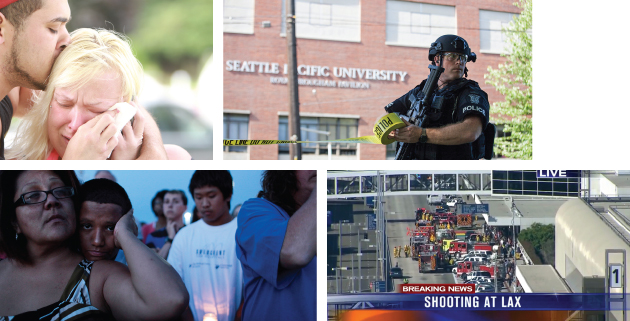
“I think we’re absolutely key,” Lucia McBath told me in April, outside the packed Indianapolis hotel conference room where a delegation from Moms and Everytown was holding a press conference against the backdrop of the NRA annual convention just a few blocks away. McBath, whose teenage son, Jordan Davis, was gunned down in 2012 in a dispute over loud music by a man citing Florida’s broad self-defense laws, speaks softly but emphatically. “Mothers know how to get things done,” she continued, explaining that they can motivate each other and connect with families in a way no one else can. “A lot of mothers are suffering in this country over the nature of the violence.”
McBath has been astonished by the outpouring of support in the wake of her son’s death. “I feel like I have a whole nation praying for our family, and I’m deeply humbled by that.” A fundamental shift on guns is inevitable, she says. “With the tobacco industry—how many years and how much effort did that take? Or gay rights? To change the culture you have to change the mindset, and that takes time. I know we will succeed.”
Erica Lafferty was 27 when her mother, Sandy Hook principal Dawn Hochsprung, was slain confronting Adam Lanza. She took up the cause just three months later. “I could literally hear her voice in my head,” Lafferty told me in Indianapolis. “‘Child, get out of bed and do something productive.'” After a year of speaking out and lobbying Congress with Mayors Against Illegal Guns, she met Watts—”she just gives me this mom hug”—and it struck her: Had the roles been reversed, had she been killed and her mother become an activist, “she absolutely would not be doing what I’m doing,” focusing on politicians in Washington. “She’d be doing what Shannon is doing, gathering all of these moms.”
Confronting child gun deaths—especially those stemming from negligent storage or use of firearms, which go unprosecuted in many states—is an obvious imperative for Moms. “It’s hugely important to our organization,” Watts told me. The strategic promise is also clear: In the early 1980s, most Americans saw drunk-driving deaths as “a problem you had to live with,” according to Hurley. Among MADD’s crowning achievements was to redefine them as crimes. MADD put relentless pressure not just on political leaders but also on the liquor industry—in no small part by turning a spotlight on kids who had been killed.
Last Christmas Eve in Lancaster, Pennsylvania, a man who’d been “messing with” a 9 mm handgun unintentionally shot and killed his two-month-old daughter as she slept in her glider. The coroner ruled the death a homicide, yet local law enforcement officials said they were undecided about pursuing criminal charges. Typically that might’ve been the end of it, but Moms Demand Action voiced outrage via social media and the local press. Within two weeks the DA announced plans to prosecute. (He said no outside group influenced his decision.)
“While we fully support the father being held accountable for this crime, we also acknowledge the horrific grief this family is experiencing,” Moms Demand Action said after the charges were announced. “We hope their tragedy can serve as an example that encourages others to be more responsible with their firearms.” The father later pleaded guilty to involuntary manslaughter and reckless endangerment, which could have brought up to 15 years in prison. He got six years’ probation and no jail time.
Moms also drew attention to a case in February in North Carolina, where a three-year-old boy wounded his 17-month-old sister after finding a handgun that their father—who wrote a parenting advice column in a local paper—had left unsecured. (The infant recovered.) “The parents have been punished more than any criminal-justice system can do to them,” a captain from the county sheriff’s department said soon after the shooting. After Moms swung into action, the father was charged with failure to secure his firearm to protect a minor; his case is pending.
“All too often DAs are loath to get involved, saying a family has suffered enough,” Watts says, “especially in states where laws are inadequate.” But just as MADD battled to tighten drunk-driving standards and stiffen penalties, Moms is pushing to toughen negligence and child-access prevention laws. One study found that 43 percent of homes with guns and kids have at least one unsecured firearm, and in 2013 at least 52 children killed themselves or others after coming across loaded guns, a Mother Jones investigation showed. “This idea of ‘accidental’ gun deaths, when something is truly negligence, has to be remedied,” Watts says.
Moms Demand Action has also campaigned aggressively for laws to disarm domestic abusers—legislation categorically opposed by the NRA until it quietly began moderating its stance this past year. Every year more than a million women are physically assaulted by an intimate partner, and when a gun is present, the likelihood of their being murdered goes up more than fivefold. Women regularly are shot to death even after obtaining court protection orders against their abusers, according to a New York Times investigation last year. The phenomenon was on grim display again in July, when a man who’d had multiple restraining orders against him shot to death six of his ex-wife’s family members in Texas, including four children. Thanks in part to Moms’ lobbying, six states have moved on the issue in 2014, including Wisconsin and Louisiana, where bills were signed by conservative governors Scott Walker and Bobby Jindal.
Moms has also chipped away at the status quo by battling state laws that allow people to pack heat in schools or bars and by working with cities to require “social responsibility” measures (such as preventing their products from appearing in video games) from gun manufacturers bidding for lucrative police department contracts.
Universal background checks for gun buyers these are not, acknowledges Mark Glaze. But what’s one of the first things you have to do if you want to sustain a movement? “You have to rack up some victories.”
It’s no coincidence that from the start Moms Demand Action has been armed with effective slogans and well-orchestrated campaigns against corporations: Watts has deep experience—from the other side. Before she decided to become a stay-at-home mom in 2008 when her youngest kids started middle school, she spent a decade as a PR executive for large firms, including Monsanto, where part of her role was to defend their controversial GMO products. She also handled crisis communications for corporations at FleishmanHillard; prior to that she’d been an aide to a Democratic Missouri governor and a speechwriter in the state Legislature.
All of which her detractors have tried to use against her. “Shannon Watts may be a liar, but she’s a professional liar,” the editor of BearingArms.com scoffed recently about her résumé. Opponents have also invoked her career to declare that she’s not a real grassroots mom and denounced her as a “Democratic Party operative.” And that’s the tame stuff. As Moms’ clout has increased, gun rights activists have aggressively targeted its members and leaders, calling them “Bloomberg’s whores,” “thugs with jugs,” and far worse. Watts has been at the receiving end of menacing phone calls and violent images posted online. She gets emails from people threatening to rape and murder her and her children. “They call me every horrific name you’ve ever heard, and say they hope that if I die it gets televised so they can watch,” she told me. (Watts has alerted the FBI to specific threats and has noted publicly that her home is protected by dogs and an alarm system.)
For decades the gun rights movement has relied on aggressive rhetoric—an overbearing government is coming to take your guns—and during the Obama presidency the NRA’s leadership has doubled down on stoking anger among its members. But in its most exaggerated form, and directed at a group of sympathetic women, that rage has created a public relations nightmare for the gun lobby—particularly in Texas, where Moms Demand Action has 7,000 active members and counting. In late April, as I first reported in Mother Jones, a veteran NRA board member in Houston confronted the leader of Open Carry Texas, warning that the backlash from flaunting semi-automatic rifles in public was jeopardizing the gun lobby’s longtime control of “a massive number of votes” in the Statehouse. The head of Open Carry Texas retorted that the NRA was siding with the “ultraliberal gun-control bullies” of Moms Demand Action. Some members of Open Carry Texas used disturbing intimidation tactics, including hounding a Marine veteran through city streets with assault rifles, shooting up a naked female mannequin, and publicizing a woman’s personal information online and exposing her to vicious harassment.
By June, the NRA’s lobbying wing made an extraordinary move, denouncing the Texas activists’ demonstrations as “foolishness” and “downright weird.” But when the enraged activists cut up their membership cards, the NRA beat a fast retreat and apologized.
Whipping up gun rights die-hards in recent years may have helped it sway lawmakers and elections. But in the process, the century-and-a-half-old NRA, once known for championing marksmanship, hunting, and gun safety, has all but ceded that legacy. And while most of its members, polls show, favor gun safety measures such as broader background checks, closing loopholes, and securing guns from the mentally ill, the leadership has stuck to its hardline position.
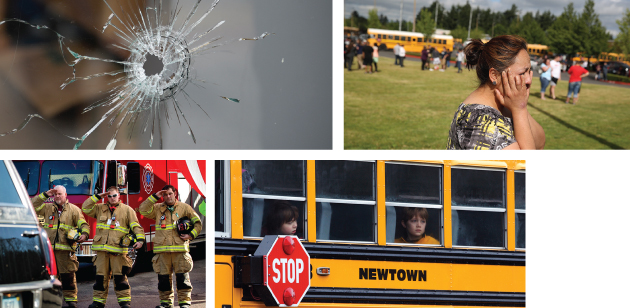
Key to Moms’ message is that being a socially responsible gun owner has nothing to do with being anti-gun. In fact, some of the leadership is deeply experienced with firearms. As an ER nurse in Seattle, Moms regional leader Kelly Bernado has cared for patients physically shattered by gun violence—but as a police officer in the 1990s, she often rolled up on armed suspects and faced split-second decisions with her weapon drawn. “I find the people who carry weapons and think they can be some sort of hero in these situations absolutely ridiculous,” she told me. (Though she came “very, very close” in one domestic-violence situation, Bernado never fired on anyone during her career.)
Kellye Burke, who grew up in rural Texas in a family tradition of gun ownership dating back to frontier days, says it was the notorious “good guys with guns” speech from the NRA’s Wayne LaPierre one week after Sandy Hook that drove her to action. “It just personified the sickness and the callousness that has overtaken our country,” she says. “The fact that they’re still not acknowledging that this is an actual problem—it’s just zero accountability and zero responsibility. And that trickles all the way down to the individual gun person who thinks, ‘I can do whatever I want and basically screw everybody else.'”
The ripple effect that certain gun deaths now have across social media—from Trayvon Martin in Florida to two-year-old Caroline Sparks in Kentucky to college kids in Santa Barbara—echoes their comprehensive toll. Thirty-thousand Americans die from guns every year, but assume that even just five people are severely affected by each person’s death and now the damage afflicts 150,000 more Americans annually. Over 10 years, that’s a total of 1.8 million people. Now add the number of gunshot victims each year who survive—one Centers for Disease Control and Prevention estimate suggests at least 64,000, not including accidents—and the overall number of Americans directly affected by shootings each decade climbs to 5 million.
“Newtown concentrated the horror in one place,” as Judith Palfrey, former president of the American Academy of Pediatrics, told me at the one-year anniversary. Still, polls show that few Americans vote based on gun policy. The most ambitious goal of Everytown, with Moms Demand Action as the vanguard, is to alter that calculus—and they may just have a chance. “Moms are an important and powerful constituency that can uniquely tap into the emotion of the electorate,” says GOP strategist McKinnon. “At the very least they can get a hearing. Whether or not they can actually mobilize voters, we don’t know yet.”
Leaders of the movement preach patience as well as tenacity. “The NRA has been in this for a very long time, so I don’t only see this through the lens of 2014,” says Howard Wolfson, a top political adviser to Bloomberg. “This is not a one-time electoral effort.”
The leading new gun reform groups share the same essential goals, though there are differences on how to achieve them. Americans for Responsible Solutions, the super-PAC and lobbying shop started by former congresswoman and mass-shooting survivor Gabrielle Giffords and her husband, Mark Kelly, is throwing millions of dollars this year behind 11 Senate and House candidates who back stricter gun laws. However, the group won’t target Democrats such as Sens. Mark Pryor of Arkansas or Mark Begich of Alaska, who voted against the background check bill.
Support for allies “is obviously very helpful,” Wolfson told me, “but there are two sides to this coin. From our perspective, we also want to make sure the people who oppose gun safety pay an electoral price.” In July, Everytown rolled out a 10-point questionnaire for congressional candidates on gun safety priorities; the plan is to reward supporters and go after those who don’t measure up—even if, says Wolfson, that means endangering the slim Democratic majority in the Senate. It’s a page straight from the NRA playbook.
“This is about building a foundation,” Watts says, “and it can’t be built on whether you have Democrats or Republicans in office. Many Democrats have shown that they are just as in the pocket of the NRA as their Republican counterparts. This has to transcend political labels.”
As Watts sees it, that’s the only way to defeat the ingrained “nothing happened, nothing will” narrative that so frustrates her and the women who’ve joined her. “It’s such a ridiculous idea that because something doesn’t pass in weeks or months that all hope is lost.”
For more of Mother Jones’ reporting on guns in America, see all of our latest coverage here, and our award-winning special reports.

